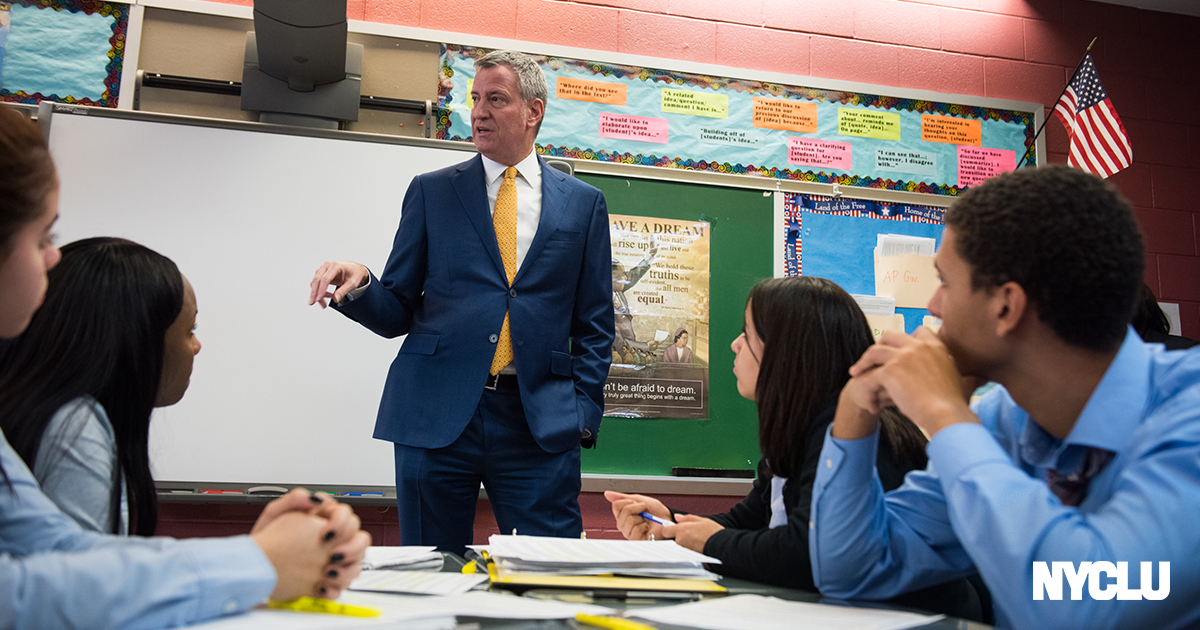De Blasio’s Education Legacy
A look at the Mayor’s achievements, failures, and what must happen next.

When New York City Mayor Bill de Blasio came into office in 2013, he pledged to chart a new path on education policy.
His predecessor, Mike Bloomberg, presided over soaring suspension rates that came as a result of a zero tolerance discipline policy which put police front-and-center in school discipline. De Blasio, by contrast, promised to make schools “safer, fairer, and more transparent.”
While he did usher in lower suspension rates and implement reforms to reduce arrests, de Blasio never successfully addressed the disparities between who gets punished in City schools and who gets a second chance. Black, and Latinx students, as well as those with disabilities, still continue to bear a disproportionate burden of school suspensions and arrests.
A major driver of these disparities is the fact that de Blasio’s schools are still flooded with thousands of police officers.
What he promised
De Blasio pledged to reduce the frequency and length of suspensions and to minimize arrests and referrals to police for school-based infractions. He also committed to making school disciplinary practices more transparent and implementing non-punitive, positive approaches to misbehavior.
De Blasio further promised to reduce disparities in who gets punished and to curtail the use of metal detectors, which increase police interactions and can make students feel like prisoners in their own schools.
Where he succeeded
During the 2018-2019 school year, suspensions dropped 10.5 percent from the previous year and nearly 39 percent over the last five years. At the same time, major crimes on campuses dipped by 32 percent. This continued a pattern from the end of the Bloomberg years of increasing safety and decreasing punishments in schools. Importantly, it proves wrong the Giuliani-era belief that students of color should be treated as suspects.
But these important achievements were not accomplished in a vacuum. In 2010, for instance, after years of advocacy from students, parents, educators, and groups like the NYCLU, the City adopted the Student Safety Act, which helped shine a light on the incredible damage caused by zero-tolerance discipline policies.
Throughout his time in office, advocates have pressed de Blasio to continue to reduce draconian discipline. To the extent he did so, he was pushed in the correct direction by grassroots groups.
Where he failed
Though overall arrests, summonses, and suspensions fell under de Blasio, the stark racial disparities in school discipline persisted. And the size of the NYPD school safety division continued to grow, despite already being one of the largest police forces in the nation.
In 2019, for example, Black and Latinx students made up 66 percent of student enrollment but were involved in nearly 89 percent of police interventions in schools. Meanwhile, white students, who made up 15 percent of the school population accounted for only five percent of arrests. Students who are handcuffed while experiencing emotional distress are overwhelmingly Black.
And although overall suspension numbers are down, schools still utilize them too often, punishing Black students and students with disabilities at far higher rates than their white peers. Black students are twice as likely as students of other races to be suspended from school. And during the 2019-2020 school year students with disabilities made up 20 percent of the student population but nearly 40 percent of suspensions.
De Blasio also failed to seriously reduce the City’s reliance on metal detectors. There are around 90 school campuses with permanent metal detectors and as of 2017, only one school requested to have them removed. This is largely due to the challenging hurdles that schools must navigate to remove scanners from school buildings. But it can also be blamed on a lack of leadership and direction from the Mayor, and a failure to invest enough in initiatives that would actually improve school climate.
There are still far more officers than guidance counselors and mental health professionals, and de Blasio never completely embraced initiatives like restorative justice – where students come to understand why their behavior is harmful and how to resolve conflict productively – preferring to leave intact officers’ authority to treat students like criminals.
What happens now
There are many ways to create safe and supportive schools that have nothing to do with police. More support for restorative practices, school counselors, mental health experts, and after-school programs can help get to the root of misbehavior.
We need much more training for superintendents, administrators, teachers, and parents on ways to ensure school safety and create positive school environments.
The City must also overcome its overreliance on permanent metal detectors. These devices superficially address school safety in a way that doesn’t get at the root causes of violence, while also creating another pathway for students to be arrested or kicked out of school.
Finally, we must realize that police have no role in a healthy, safe school climate. We must work to reduce and eventually eliminate police officers from schools.
Until these issues are addressed, de Blasio’s education legacy will be one of unfulfilled promises.
